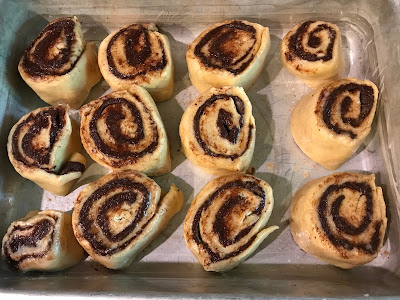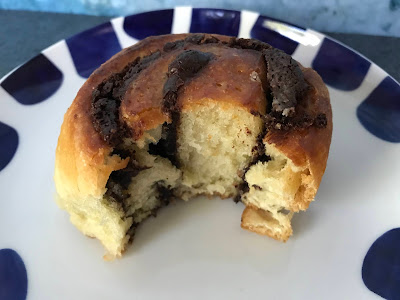I made some peanut butter cup cookies with leftover Halloween candy a while back, and they happened to be vegan and gluten-free, but they didn’t impress me much. The ones that DID impress me were these soft chocolate sugar cookies. They are “drop” sugar cookies, no rolling pin or cookie cutters or icing required. As the name implies, they are soft and *intensely* chocolatey, and absolutely wonderful! The best part is that just one of these cookies really satisfied me (I don’t know about you, but I’m happier with that than with always grabbing another one off the baking sheet and still feeling like I want more). I really recommend these!
Note that they call for both softened and melted butter, which keeps them very moist, as well as at least one hour of refrigeration. Now, I know some of you might be tempted to skip this step, but don’t! You’d end up with really flat cookies, which would be a shame.
I got a total of 18 cookies, which I only baked a batch at a time – no more than 12 per baking sheet.
½ cup lactose-free butter, melted
½ cup lactose-free butter, at room temperature
1 cup brown sugar (packed)
½ cup granulated sugar
2 large eggs
1 ½ tsp. vanilla extract
½ tsp. expresso powder (I used instant coffee)
2 cup all-purpose flour
¾ cup +2 Tbsp. unsweetened cocoa powder, sifted
1 tsp. baking soda
¾ tsp. salt
1/3 cup granulated sugar, for rolling
In the bowl of a stand mixer (or a large mixing bowl with a hand mixer), beat the butters and sugars until light and fluffy, about 4 minutes.
Add in eggs, one at a time, mixing well after each addition. Add vanilla and espresso powder, mix until combined.
In a medium mixing bowl, whisk together the cocoa powder, flour, baking soda, and salt. With mixing speed on low, gradually add the dry ingredients. Mix until a soft dough forms.
Cover the dough with plastic wrap and refrigerate for at least 1 hour.
Preheat oven to 350 °F. Line a baking sheet with parchment paper or a silicone baking mat; set aside.
Using a standard size cookie scoop (I *think* mine is 3 tablespoons?), scoop dough and roll in the granulated sugar, if desired. Place on prepared sheet, then bake for 8-10 minutes (this took 10 minutes for me, with the dough straight from the fridge). The cookies should be soft in the center but set on the edges.
Remove from the oven and allow the cookies to cool on the sheets for 5 minutes before transferring to a wire rack to cool completely.




























































